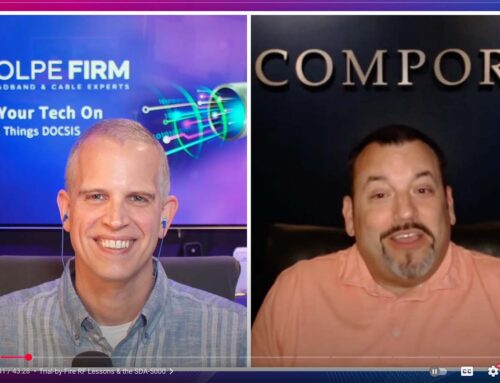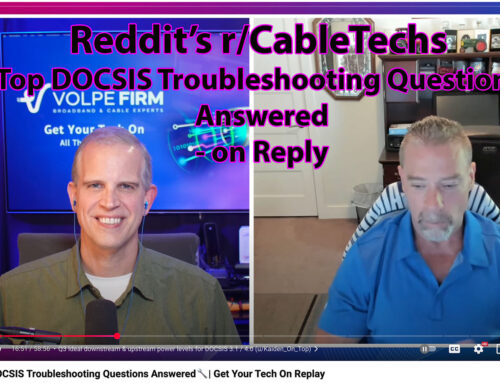Podcast: Play in new window | Download | Embed
Subscribe: Spotify | Email | RSS | More
What is cloud native virtualization and what does cloud native virtualization mean to DOCSIS and broadband networks? This is a special series of Get Your Tech On, our show on All Things DOCSIS. I’m Brady Volpe, Founder of The Volpe Firm and Nimble This and today we have a special guest Asaf Matatyaou, Asaf Matatyaou Vice President, Solutions and Product Management, Cable Access Business at Harmonic, and we explore this topic as it is becoming a big focus in the way we deploy and manage our networks through cloud native virtualization.
Listen or watch Brady and Asaf discuss virtualization and what it means to cable systems and networks. How it can improve the network. Lessons learned? What about the F connector? So many questions and we have the answers.
Virtualization a Deep Dive:
- Cloud native and what it means to the broadband industry
- Virtual CMTS – lessons learned
- taking existing technology and applying it to cable tech / access
- CCAP / CMTS / Edge Qam
- IPDR / control panel / data plane = cloud native virtualization CMTS
- Orchestration and eliminate the need for customer hardware
- Leverage existing technology
- Hard from existing CMTSs and putting into a server / computer
Benefits
- more responsive in software
- improve performance in software more easily
- better then fixed function hardware
- adapt quicker to security threats
- easily increase capacity
- better space usage
- better ability to grow
- easy for smaller deployments
- less power consumption
- better foot print
- elasticity
- feature requests
Common collection framework
- Want to add a new feature in Virtual CMTS?
- Framework
- Metrics
- Presentation layers
- What objects do you want to add?
- Faster turnaround
- PNM data
Can my old computers be CMTSs?
- General purpose CPUs
Where do the F connectors go?
- F connectors are still in hardware
- DOCSIS how does virtualization work with the physical layer?
- Form factor
- How do you get to RF?
- What about the physical layer?
- Transmit using the Remote-PHY protocol – UFB, GCP etc
- Virtual CMTS / CCAP it goes to the Remote-PHY device
Cloud native
- Containerization
- Helps with deployment
- Dynamic Orchestration
- Kubernetes
- Micro-services
- Traditional CMTS vs Virtual CMTS
- Modularity – leverage economies of scale
How does it effect plant guys?
- How to add new capacity easily?
- How to overcome capacity issues?
- Scale up a CMTS or service group
- Architecture that lets you add more capacity
- Pressure on the upstream
- Labor constraints
- Faster and easier reaction to shifting demands
- New node splits
- Operational simplicity
- Pin-point capacity shortages
Why is it with virtualization do you have more visibility in Network Congestion?
- Metrics
- Data is much greater – stream of data vs snapshot of data with SNMP
- Hard to add counters into hardware
- Hardware Architecture not micro-services designed in CMTS
- You can add more compute services – independently
- Adding more processing power for micro-services
- SNMP vs more modern telemetry
A more realistic services that get a lot of load that need scaled up – heavy load system
- What demands more processing
- Subscriber load changes dynamically
- Load on data processing
- Node splits – per service group
- Higher bandwidth rates
Node splits – How does a virtual CMTS do Node Splits vs traditional CMTS?
- Everything is IP
- Eliminates the need to use patch panel
- PNM benefits
- Save space, powering, reduce human error in RF connections
- Majority of connections become IP
- Scale up node splits faster
- Remote or DAA – reduce labor
Deploy remote- which one? Remote-PHY shelf vs remote-PHY in the field?
- Budget
- co-locate devices
- DAA
- address all types of footprints
- RF deliveries out of the headend or hub
- Flexible for operators
- Mixed footprint
Remote-PHY shelf allows you to use your existing optics, forward path transmitters and your return path receivers – Is the shelf a stepping stone to remote pay out in the field?
- DAA and how it works with virtualization
- Remote-PHY shelf benefits
- Converge services
Where does the cloud native technology live?
- Deep at the node
- Data centers
- compute sources in the headends or hubs – as stepping stone
- reclaim space and save resources
- outdoor enclosures
- live in public cloud or private cloud
- AWS or Google cloud compute?
- How does a CMTS live in a locker out in the street?
- Security of services living in Google or AWS?
- Technology is an enabler
- Neighboring industries have addressed the concerns that cable operators have in their industry
What is the future?
- Multi-tenent to address pin and wireless
- low latency
- overlay applications to address service needs
- DOCSIS pressure
- Look at network holistically
- addressing needs of DOCSIS 4.0
- Just a software upgrade
- Just upgrade a server to go to DOCSIS 3.1 and DOCSIS 4.0
- you still need to upgrade the physical layer
- what are the next pressure points?
- Harmonic overview
End Podcast
Asaf thank you for your time today. This was a great episode. Our next Episode 63 in August 14th with John Downey.
You can watch us live or recorded on Youtube or listen to us on your favorite podcaster. Links to everything is on the volpefirm.com webpage.
If you have enjoyed this webcast, please do hit the subscribe button so that you never miss an episode.
Thank you so much for being here and we will see you next month.
Upcoming events can be seen under Broadband Events. Previous events can be seen under the blog.
- If you are watching this on youtube please hit the subscribe button!
- Let us know what you think and remember to share!
- You can find slides at the bottom of the page and some on slideshare.
- Find out about events or articles by following us on Twitter, LinkedIn or Facebook too.
Also available on iTunes, Google Podcasts, Spotify, vurbl see podcasts “get your tech on”.





Leave a Reply